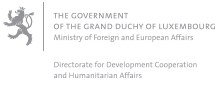- Home
- Preface
- I. Luxembourg’s official development assistance in 2013
- ICT used for humanitarian and development purposes
- Post-2015: the state of play
- II. Cooperation with the main partner countries
- III. Regional cooperation and cooperation with other countries
- IV. Multilateral cooperation
- V. European Union
- VI. Cooperation with non-governmental development organisations
- VII. Humanitarian action
- VIII. Programme support
- IX. Development education and awareness-raising
- X. Microfinance
- XI. Evaluation
- XII. Report on the progress of the work of the Interministerial Committee for Development Cooperation
- Appendices
IV. Multilateral cooperation

Meeting between Ministers Spautz and Di Bartolomeo with Dr Mark Dybul, Executive Director of the Global Fund
The Global Fund to Fight AIDS, Tuberculosis and Malaria: structural re-organisation and the Fourth Replenishment
2013 was a major turning point for the Global Fund to Fight AIDS, Tuberculosis and Malaria, with its structural re-organisation bearing fruits. The reform process began in 2011 with the development of a new 2012-2016 strategy and a new funding model, which was launched in several stages between 2013 and 2014. By replacing the rounds-based approach, which the GFATM had used since its creation eleven years ago, this new funding model is revolutionising the way in which the Fund works. It is anchored in national health plans and strategy and dialogue with the country concerned. The objectives are to ensure more predictability for implementing countries; to align the GFATM funding process with countries’ national cycles; to adapt the programmes to countries’ situations; and to ease the burden for implementers. Through this new system, the majority of the Global Fund’s resources are now dedicated to the poorest countries with the highest disease burden and, in contrast to the previous system, countries now have a clear indication of the funds which they will receive. 2014 will see the culmination of the reform process and the launch of the new funding model in all the GFATM’s recipient countries.
The pledging conference of the Fourth Replenishment cycle 2014-2016 of the Global Fund took place in Washington DC on 3 December 2013. The objective was to raise 15 billion US dollars for those three years. Even though this objective has not (yet) been reached, the conference was a great success, securing 12 billion US dollars. A large number of countries significantly increased their contributions. Luxembourg has maintained its funding at 2.5 million euros annually with a three year commitment.

